This article was published in Scientific American’s former blog network and reflects the views of the author, not necessarily those of Scientific American
Late last year, Steve White’s Dinosaur Art II: The Cutting Edge of Paleoart appeared in print, the follow-up volume to the much-lauded Dinosaur Art: the World’s Greatest Paleoart (previously discussed here). Dinosaur Art II’s success and appeal might be demonstrated by the fact that the entire stock brought along to 2017’s TetZooCon sold out during the first coffee break; it’s a fine volume that you absolutely must obtain if interested in modern thoughts on the visual representation of prehistoric animals. As with the first volume, I was scientific consultant, and assisted Steve – ably, I hope – in fact-checking and assorted technicalities. I’m honoured to be involved in this most worthy project.
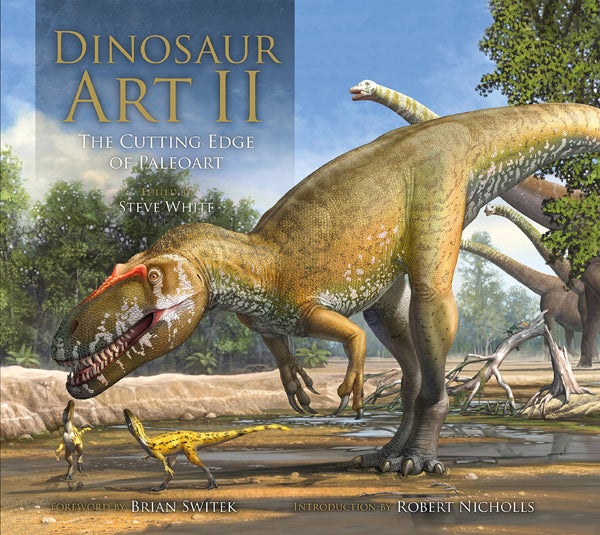
The cover of Dinosaur Art II. You should totally buy a copy. Credit: Titan Books
For Dinosaur Art II I was also asked to do something that extended beyond my duties as consultant: to write a bit of biographical text on one of the featured artists, my long-standing colleague and associate Dr Mark Witton. Mark is well known today as an influential palaeoartist producing outstanding and innovative artwork depicting prehistoric life of all kinds. You can follow his artsing adventures at his blog, and do also keep an eye out for his next book: the soon-to-appear The Palaeoartist’s Handbook. Mark is also a qualified scientist who publishes technical research on pterosaurs (most recently: Witton 2013, 2015, 2018). We’ve co-authored on a few occasions (Witton & Naish 2008, 2015, Witton et al. 2014, Naish & Witton 2017). Anyway… for reasons of space and design, my brief text on Mark couldn’t be included in the final volume. So, with Steve’s permission, I’m recycling it here, and I hope you enjoy it.
On supporting science journalism
If you're enjoying this article, consider supporting our award-winning journalism by subscribing. By purchasing a subscription you are helping to ensure the future of impactful stories about the discoveries and ideas shaping our world today.
Mark Witton and I have known each other for over ten years, our mutual interest in pterosaurs being the main reason for a series of collaborations that began in 2006 and have continued to the present. Over this time, we have worked repeatedly on the amazing and often gigantic azhdarchids, and in particular on their lifestyles and foraging and feeding behaviour. I’ve also acted as advisor to Mark in his production of dinosaur-themed artwork, and have collaborated with him in work that tackles broader aspects of palaeoart (see our 2014 article with John Conway, ‘State of the palaeoart’).
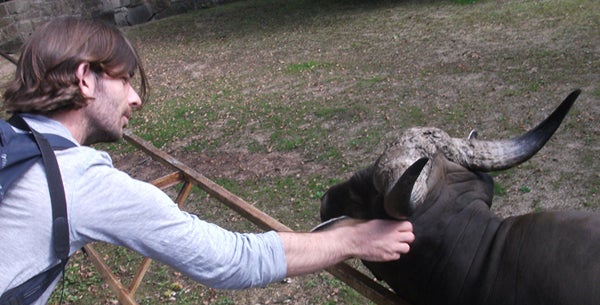
Dr Mark Witton and a Banteng Bos javanicus. Mark is on the left. Credit: Darren Naish
Following a series of discussions about the anatomy and lifestyles of azhdarchids, Mark and I made the decision to turn our hypothesis into a technical paper. We eventually succeeded, our work appearing in PLoS ONE in 2008. At the time, Mark and I were both PhD students at the University of Portsmouth where we occupied adjacent offices as part of David Martill’s vertebrate palaeobiology research group. Mark and I had tried in vain to convince Dave that pterosaurs were not the oceanic dip-feeders or skim-feeders that he and his colleagues had proposed: this was a subject we argued about constantly, at least for a while (these days, Dave mostly agrees with us*). The case presented by Mark and I – we proposed that azhdarchids were terrestrial stalkers, proficient at walking and making a living by picking up small animals from the ground – combined data from functional morphology, anatomical proportions and palaeoenvironment. As a new, dynamic and exciting view of a weird group of animals, it got a lot of attention and a claim can be made that our paper is one of the most-read pieces of literature on pterosaurs ever published.
* The original version of this text mischaracterised Dave’s position, for which I apologise.
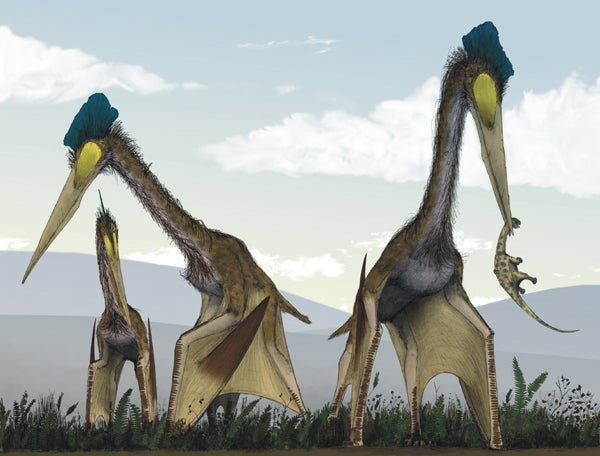
A (now somewhat dated) reconstruction of an azhdarchid group foraging in a Late Cretaceous fern meadow, one snagging a baby titanosaurian sauropod for lunch. And thus a meme was born. Credit: Mark Witton, Witton & Naish 2008 (CC PLoS ONE)
Mark and I wanted to include a life reconstruction of a foraging group of azhdarchids in the paper, our thinking being that it helps to ‘flesh out’ a given hypothesis with a piece of art. Mark had already produced a colour image – done to accompany his talks on pterosaur mass estimates – showing a giant azhdarchid to scale with a giraffe and a human, so this seemed like a logical next step.
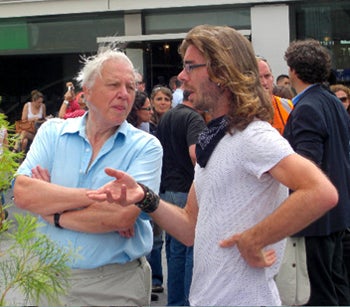
Mark Witton chats to Sir David Attenborough about azhdarchid pterosaur palaeobiology. Credit: Darren Naish
While the piece looks technically naive compared to the work Mark produces today, it features several key elements of what I’ve half-seriously termed Wittoniana. The animals are shaggy and almost unkempt, are mostly decked out in muted earth tones (apart from brighter colours on the face), and are very much animals of their realistically cluttered, naturalistic environment. There are some autobiographical elements here but, more seriously, these different strands, combined, reflect both a thorough knowledge of the fossil evidence we have with what I think is a grounded and well informed view of the natural world, and of animal life appearance and behaviour. This is the way palaeoart should be headed, and Mark has said as much in his books, talks and articles. Less open-mouthed dragons screaming towards the viewer; more animals, behaving like animals, depicted in wild environments.
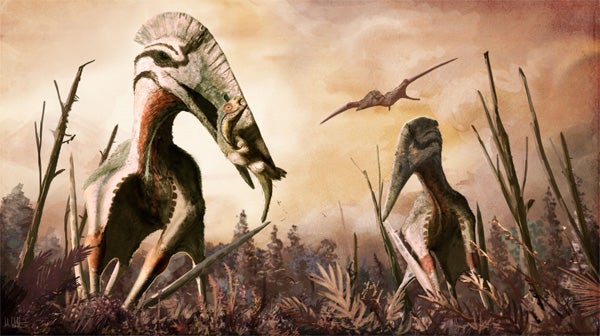
Wittonesque azhdarchids of 2017: the giant, robust-necked Romanian taxon Hatzegopteryx, illustrated as a terrestrial predator of mid-sized vertebrate prey in accordance with the model published by Naish & Witton (2017). Credit: Mark Witton, Naish & Witton 2017, PeerJ
Since that pioneering image of 2008, Mark has of course produced azhdarchid images on numerous subsequent events. Our knowledge of their proportions and anatomy has changed as new data has come in, and Mark’s style has evolved, a more painterly style becoming obvious over the years. At the time of writing (early 2017*), his dynamic image of a foraging Hatzegopteryx pair represents his latest take on these animals. The animals are dynamically posed, their colouration and external texture feels natural, and the flora, background, overall palette and nature and colour of the sky show substantial nuance and texture.
* This text was written before we’d published the relevant research, and thus before the images concerned had been published and shared online.
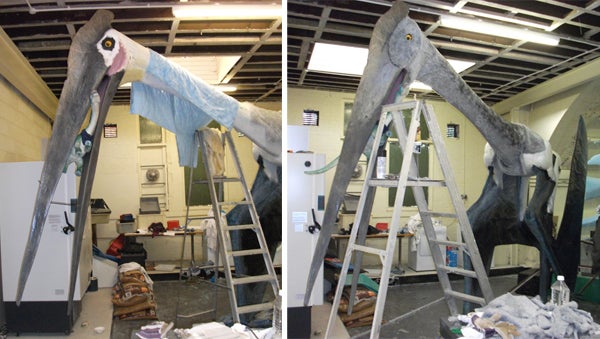
During the latter part of 2009, Mark, David Martill and a team of helpers built a group of life-sized pterosaur models - among them this large azhdarchid - for display at the Royal Society Summer Science Exhibition of 2010. It was a real thrill to see these models come together. Credit: Darren Naish
Finally, I have often thought that one of the ultimate accolades as an artist of the two-dimensional medium is to be awarded the chance to have your work realised in gigantic form, or in sculpture. During 2009 and 2010, Mark was part of a University of Portsmouth team that compiled and constructed an exhibition on azhdarchids and other pterosaurs for the Royal Society Summer Science Exhibition, held on London’s South Bank during the June and July of 2010. I was not directly involved in this project, but seeing it come together in the workshop was a great thrill. The results were spectacular and exciting, in particular the two life-sized, terrestrial stalking azhdarchids. Mark’s work on azhdarchids had made the transition from digital artwork and two dimensions to full size and three dimensions, and a most successful transition it was.
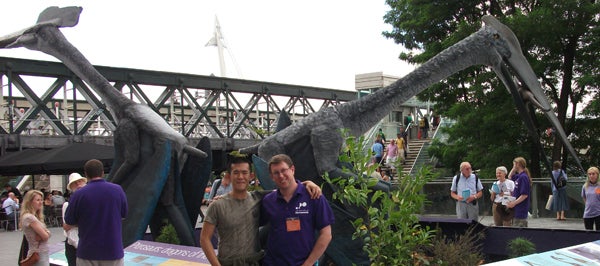
I don’t have any especially good photos of Mark with the Royal Society Summer Science Exhibition pterosaurs. But here’s me (in the dark t-shirt) with Ed Yong, Mark’s two big azhdarchids behind. Ed and I are not a couple, despite appearances. Credit: Darren Naish
For previous Tet Zoo articles relevant to the issues covered here, see...
What does it feel like to get bitten by a ground hornbill, I hear you ask?
A new azhdarchid pterosaur: the view from Europe becomes ever more interesting
Daisy’s Isle of Wight Dragon and why China has what Europe does not
Quetzalcoatlus: the evil, pin-headed, toothy nightmare monster that wants to eat your soul
Some Azhdarchid Pterosaurs Were Robust-Necked Top-Tier Predators
Refs - -
Witton, M. P. 2015. Were early pterosaurs inept terrestrial locomotors? PeerJ 3, e1018.